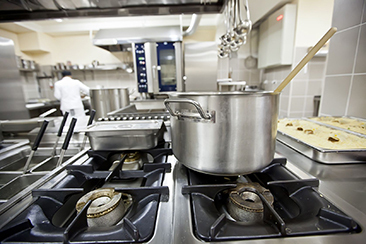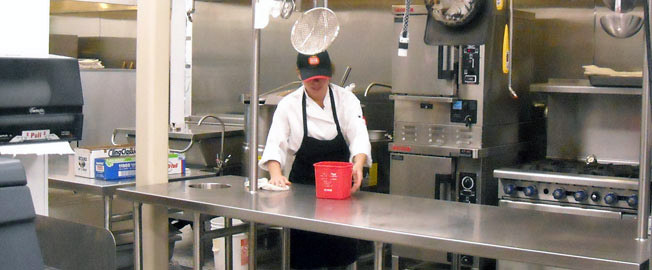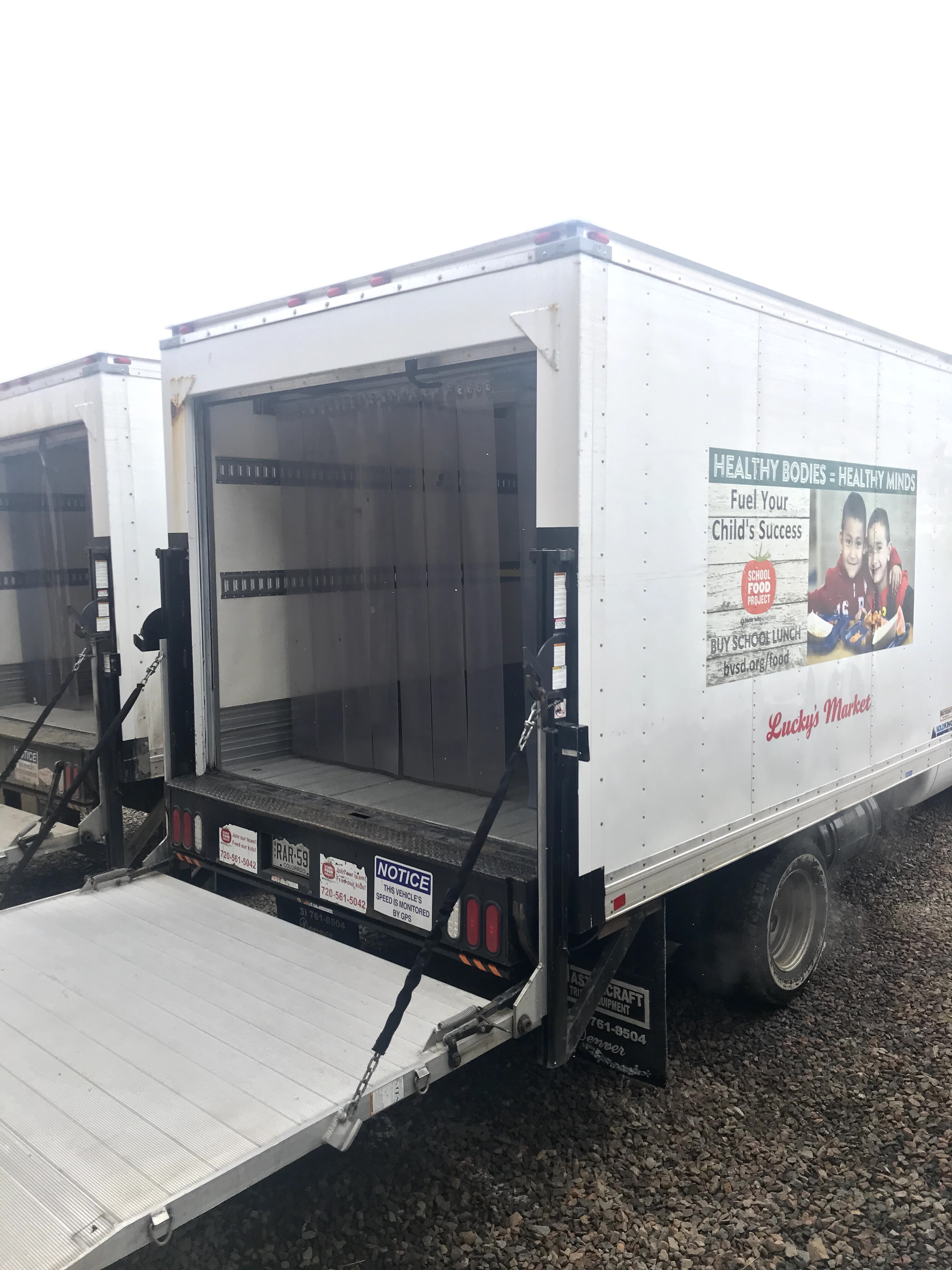
Equipment
Commercial grade, high volume kitchen equipment can be an expensive proposition, but there is payoff in the amount of energy that can be saved. Read more about equipment efficiency, sustainable cleaners and transportation in this section.
The Sustainable Lunchrooms case study covers: food and procurement, equipment (current page), student engagement, and certificates and resources.

Equipment
Commercial grade, high volume kitchen equipment can be an expensive proposition, but there is payoff in the amount of energy that can be saved. Read more about equipment efficiency, sustainable cleaners and transportation in this section.
The Sustainable Lunchrooms case study covers: food and procurement, equipment (current page), student engagement, and certificates and resources.
Food Waste: Back of the House
In order to reduce food waste within the department, the kitchens first need to understand what amount and type of waste was being created in daily operations.
Piggybacking on the district’s partnership with Eco-Cycle’s Green Star Schools program, BVSD’s School Food Project targeted food waste as a department priority in 2017. After receiving a grant from Boulder County’s Resource Conservation Division’s Zero Waste funding program, the district installed Leanpath machines in each of BVSD’s three regional production kitchens.


Food Waste: Back of the House
In order to reduce food waste within the department, the kitchens first need to understand what amount and type of waste was being created in daily operations.
Piggybacking on the district’s partnership with Eco-Cycle’s Green Star Schools program, BVSD’s School Food Project targeted food waste as a department priority in 2017. After receiving a grant from Boulder County’s Resource Conservation Division’s Zero Waste funding program, the district installed Leanpath machines in each of BVSD’s three regional production kitchens.
Having a better understanding of the waste being generated in BVSD production kitchens informs new, creative strategies to divert waste from being composted. For example, while broccoli stems may not be ideal for the salad bar, they can be repurposed for use in dishes such as the ever-popular Broccoli- and Cheese-Stuffed Potato where pretty florets may be less necessary.
The Leanpath system also introduced opportunities to recognize staff for their efforts to track food waste. Leanpath is set up to incentivize staff for recording their waste, even if they are not immediately reducing the waste created. By tracking their waste, staff are creating opportunities to learn new techniques for food waste reduction and to understand the financial as well as environmental impacts of food waste and food waste reduction.
The Leanpath 360 FS system also allows kitchens to set goals to reduce waste over a certain time period, during a certain type of production, or for a certain product. BVSD uses this feature regularly and has implemented new procedures for breading chicken and salad bar preparation. For example, after setting a goal of reducing breading waste, it became clear that adding the breading mix to the machine at multiple times during a prep session could reduce waste by more than 25%, instead of adding the entire mix at the beginning. This simple change did not incur significantly more labor time and yielded an obvious cost savings and waste reduction.

Food Waste: Front of the House
BVSD’s regional production model and scratch cooking operation means that food waste can be created at multiple points throughout the process.
BVSD is now home to a total of 11 Leanpath machines - three in production kitchens, two in school satellite kitchens, and six in school cafeterias. Involving students in the waste stream within their school communities further supports efforts to educate students on waste reduction and how they can make a difference. Capturing this data also allows for a better understanding of the food wasted by over-ordering and helps managers work with kitchen staff to reduce or adjust orders as necessary.

Using the Leanpath Spark system in cafeterias is one of BVSD’s newest food waste reduction strategies. At the end of a meal period, students scrape their plates into a large compost bin, like they would in any BVSD Green Star School. However, schools with Spark systems have a large floor scale underneath the compost bin to weigh every piece of organic waste generated in the cafeteria. Each transaction is recorded, generating a report much like those in production kitchens. Real-time data is also displayed in school cafeterias and translated into kid-friendly statistics and equivalents, such as amount of meals lost, swimming pools of water wasted, and number of cars on the road.
Having only piloted the program as a passive communication display, and having noticed a 30% reduction in post-consumer food waste, the School Food Project is working toward the introduction of a food waste toolkit with additional classroom and practice-based learning opportunities for teachers and students to implement using data generated in their own schools.


Leanpath has been invaluable to reducing food waste across BVSD Food Services but does come with a high price tag that may be too costly for some districts. As an alternative, schools can occasionally run their own food audits to collect data on what is being wasted during meal times. While they require planning, these “manual” audits offer a hands-on opportunity for students to learn about waste reduction. This comprehensive Guide to Conducting Student Food Waste Audits offers step by step directions and sample tracking sheets.
Sustainable Cleaners
Sustainable cleaners in a school environment can pose a challenge.
With a high-risk population and the responsibility to ensure the safety of students in schools, it is not possible to use homemade, sustainable options like water and vinegar.


Sustainable Cleaners
Sustainable cleaners in a school environment can pose a challenge.
With a high-risk population and the responsibility to ensure the safety of students in schools, it is not possible to use homemade, sustainable options like water and vinegar.
However, sustainable cleaners do exist. Here’s a list of eco-friendly commercial cleaning products according to Janitorial Manager:
- SafeChoice Super Clean (all purpose)
- Greenmaker Glass and Window Concentrate
- Osmo Wash and Care (floor)
- Elements Bathroom Cleaner
- Moldex (mold inhibitor)
- Simple Green Disinfectant/Sanitizer
- Earth Friendly Products Furniture Polish
- EnviroCare Carpet and Upholstery Cleaner
- Odoban Earth Choice Toilet Bowl Cleaner
Be sure to look at the label before making any assumptions. Commercial grade “sustainable” cleaners also promote some benefits that might actually result in less sustainable outcomes. For example, just because a cleaner is advertised as sustainable, does not mean that it is any less caustic than a typical commercial cleaner - the “sustainable” label might just refer to packaging.
Similarly, higher concentrates can appear more cost effective, however some concentrations might contain fewer parts per million (ppm), making them less effective at cleaning and therefore requiring more cleaner to be used. Schools should request product details from their distributor and compare the specifications to recommendations from the EPA and other reputable sources.

Equipment Efficiency
With the increased emphasis on green school buildings, food service operations are highly encouraged to focus on energy efficiency and the financial impact of storing, preparing, cooking, and serving hundreds to thousands of meals each day.
BVSD prioritizes the purchase of Energy Star certified equipment to increase energy efficiency by 20% over traditional products. However, beyond the quality of the equipment, there are many best practices that any food services operation can implement to decrease energy costs and support a more sustainable operation:


Equipment Efficiency
With the increased emphasis on green school buildings, food service operations are highly encouraged to focus on energy efficiency and the financial impact of storing, preparing, cooking, and serving hundreds to thousands of meals each day.
BVSD prioritizes the purchase of Energy Star certified equipment to increase energy efficiency by 20% over traditional products. However, beyond the quality of the equipment, there are many best practices that any food services operation can implement to decrease energy costs and support a more sustainable operation:
Gas fired - While the cost of gas versus electricity varies widely by geographic region, BVSD chooses equipment that uses natural gas because the overall impact is lower than electric-powered options.
Keep doors closed - It may seem obvious, but training staff to keep refrigeration closed except when entering or exiting the walk-in can have significant impacts on energy use. Leaving the door open for two minutes to grab the ingredients needed for the next recipe can cause the refrigeration cycle to run for additional time. Consider how much extra energy is being used when the door is left open during a 30-minute inventory session.
Hang walk-in curtains - Like keeping the doors closed, hanging refrigeration curtain keeps the cold air in (and contamination out). While strips are common and cost-effective, BVSD has opted for bar door-style “curtains” because they are easier to navigate, have less chance to contaminate food being brought in or out, and while more expensive up front, generally last longer than low-cost strips.
Defrost at night - In order to maintain the proper food safe temperatures, and not allow refrigerators and freezers to drop to a colder temperature that damages the food, commercial equipment generally runs a defrost cycle at least once per day. Letting the equipment run too cold can damage its efficiency and decrease the lifespan of high cost equipment. Because the defrosting process requires the production of heat, running the defrost cycle at night, when doors are not being opened and closed, can reduce excess heat created through the process.
Don’t overfill - While it can be tempting to use up every inch of a large refrigeration unit, it is important to remember that good airflow is required to maintain proper temperatures and keep equipment running efficiently. BVSD ensures that satellite kitchens are not keeping a large inventory of foods in their site-based coolers and freezers by ordering each week and completing an inventory at the end of each month.
Preventative maintenance - Keeping equipment in good condition is essential to the longevity and efficient function of refrigeration and cooking equipment alike. One unaddressed repair can beget another breakdown in the system. BVSD Food Services works closely with BVSD Maintenance to address equipment issues within 24 hours. While not every school district has an in-house maintenance team, school districts can retain local vendors to provide preventative maintenance and quick repairs throughout the school year and summer.
Transportation
With nearly 14,000 meals to move from 3 regional production kitchens to 54 school-based satellite kitchens, transportation coordination and delivery logistics are essential functions of BVSD’s operation.
Spanning 500 square-miles, BVSD Food Services currently operates out of production kitchens regionally located throughout the district and one central warehouse. Each day, a team of six drivers starts at the central warehouse. In refrigerated trucks with cold storage curtains, drivers follow a set route, delivering scratch-cooked food to schools and picking up clean, used sheet pans and hotel pans to return to the production kitchens. BVSD has established a driving schedule and route to cut down on inefficient side trips and ensure predictable pick-up and delivery from the regional kitchens and warehouse to the school sites. Each truck is equipped with a GPS tracking system to support location and speed verification.
In addition to driving geographically efficient routes, delivery trucks are properly maintained to ensure they’re running efficiently. Preventative maintenance also helps avoid costly surprises. If a breakdown occurs with food on board, the loss can result in out of temperature food. This not only disrupts labor and the flow of operations, but leaves the district with a large amount of food waste and students without meals.


Transportation
With nearly 14,000 meals to move from 3 regional production kitchens to 54 school-based satellite kitchens, transportation coordination and delivery logistics are essential functions of BVSD’s operation.
Spanning 500 square-miles, BVSD Food Services currently operates out of production kitchens regionally located throughout the district and one central warehouse. Each day, a team of six drivers starts at the central warehouse. In refrigerated trucks with cold storage curtains, drivers follow a set route, delivering scratch-cooked food to schools and picking up clean, used sheet pans and hotel pans to return to the production kitchens. BVSD has established a driving schedule and route to cut down on inefficient side trips and ensure predictable pick-up and delivery from the regional kitchens and warehouse to the school sites. Each truck is equipped with a GPS tracking system to support location and speed verification.
In addition to driving geographically efficient routes, delivery trucks are properly maintained to ensure they’re running efficiently. Preventative maintenance also helps avoid costly surprises. If a breakdown occurs with food on board, the loss can result in out of temperature food. This not only disrupts labor and the flow of operations, but leaves the district with a large amount of food waste and students without meals.
Discover More






